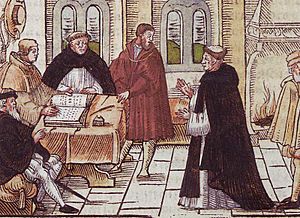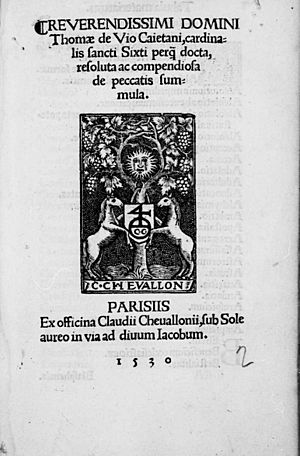Thomas Cajetan facts for kids
Quick facts for kids
Thomas Cajetan
|
|
|---|---|

Martin Luther in front of Thomas Cajetan by Ferdinand Pauwels
|
|
| Born | February 20, 1469 Gaeta, Kingdom of Naples
|
| Died | August 9, 1534 (aged 65) |
| Alma mater | University of Padua |
| Era | Medieval philosophy |
| Region | Western philosophy |
| School | Thomism |
|
Main interests
|
|
|
Influenced
|
|
Thomas Cajetan (born February 20, 1469 – died August 9, 1534) was an Italian thinker and religious leader. He was also known as Gaetanus or Tommaso de Vio. He became a cardinal in 1517 and was the head of the Dominican religious group from 1508 to 1518.
Cajetan was a very important religious scholar of his time. He is best known for speaking against the ideas of Martin Luther and the Protestant Reformation. This happened when Cajetan was the Pope's special representative in Augsburg. He also wrote many comments on the famous book Summa Theologica by Thomas Aquinas.
It's important not to confuse him with Saint Cajetan, who lived around the same time and started a different religious group.
Contents
Life Story
Thomas Cajetan was born in Gaeta, which was then part of the Kingdom of Naples. His birth name was Jacopo Vio. He took the name Tommaso when he joined the Dominican order. The name Cajetan comes from his hometown, Gaeta.
When he was fifteen, he joined the Dominican Order. He spent his time studying the ideas of Thomas Aquinas. Before he turned thirty, he became a doctor of theology at the University of Padua. Later, he became a professor there, teaching about deep philosophical ideas.
In 1494, he had a public debate in Ferrara with Pico della Mirandola. This debate made him famous as a theologian. He became a top leader in the Dominican order in 1507 and their general leader in 1508.
Cajetan strongly defended the Pope's rights. He wrote several books against the Council of Pisa in 1511. These books were even burned by order of King Louis XII. Because of his loyalty, Pope Leo X made him a cardinal and an archbishop of Palermo in 1517.
He continued to support the Pope against other councils. He played a key role at the Fifth Lateran Council (1512–17). During this council, he helped create a rule that said the Pope's authority was higher than that of church councils.
In 1517, Pope Leo X made him a cardinal in Rome. The next year, he became the bishop of Palermo. In 1519, he became the bishop of Gaeta. This was given to him by Emperor Charles V, whom Cajetan had helped get elected.

In 1518, Cajetan was sent to the Diet of Augsburg. His job was to examine the teachings of Martin Luther. Luther was questioned by Cajetan and others. Luther ended up denying the authority of a general church council.
In 1519, Cajetan helped write the official document that removed Luther from the Church.
Cajetan was also involved in many other important tasks. He helped elect Adrian VI as Pope in 1521. He kept his influence under Pope Clement VII. He was briefly put in prison after Rome was attacked in 1527. He then went back to his bishopric for a few years.
Returning to Rome in 1530, he again became an important advisor to Pope Clement. He wrote the decision that rejected King Henry VIII of England's request for a divorce from Catherine of Aragon. He also suggested some changes to help with the issues caused by Luther's ideas. These included allowing priests to marry and allowing people to receive communion in both kinds.
Cardinal De Vio died in Rome in 1534.
His Ideas
As a philosopher, Cajetan supported the idea of analogy. This means understanding something new by comparing it to something familiar.
As a religious scholar, Cajetan followed the older ideas of Thomism, which are based on Thomas Aquinas. However, he also had some new ideas. He wanted to keep the good parts of the new learning of his time. He believed this could work well with traditional Catholic teachings.
Some members of the Dominican order thought his ideas were too different from Saint Thomas Aquinas. Some of his views were even seen as wrong by the Sorbonne in Paris. In a later edition of his famous book about Aquinas' Summa, some parts were removed.
Cajetan also wrote comments on parts of Aristotle's works and on Aquinas' Summa. Towards the end of his life, he carefully translated parts of the Old and New Testaments. He also wrote about practical issues, like what to do with stolen goods when the owner couldn't be found.
He strongly opposed the Protestant Reformation. He wrote several works against Martin Luther. He played a big part in how the Pope's representatives dealt with the situation in Germany. Even though he was learned in traditional religious studies, he realized he needed to know the Bible better to argue against the reformers. He studied the Scriptures with great effort. He wrote comments on most of the Old and New Testaments. In explaining the text, he was sometimes flexible and did not always stick to the exact literal meaning.
Unlike many Italian cardinals of his time, Cajetan was a very religious and dedicated man. He believed it was very important to keep church rules. He defended the Pope's rights, saying the Pope should be "the mirror of God on earth."
Works
Here are some of the important works written by Thomas Cajetan:
- Opera omnia (Collected works, 5 volumes, 1639)
- Opuscula omnia (Smaller works, 1530)
- Commentary on Saint Thomas' Summa theologiae (1540)
- De divina institutione Pontificatus Romani Pontificis (About the divine establishment of the Roman Papacy, 1521)
- In Porphyrii Isagogen (On Porphyry's Introduction, 1934)
- De comparatione auctoritatis papae and Apologia (About comparing the Pope's authority, and an Apology, 1936)
- De Anima (About the Soul, 1938)
- Scripta philosophica (Philosophical writings, 6 volumes, 1934–39)
Images for kids
See also
 In Spanish: Tomás Cayetano para niños
In Spanish: Tomás Cayetano para niños





